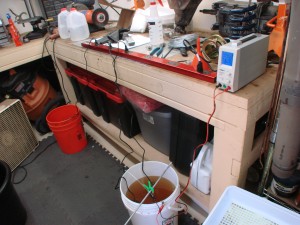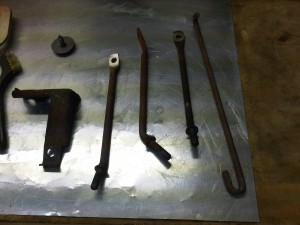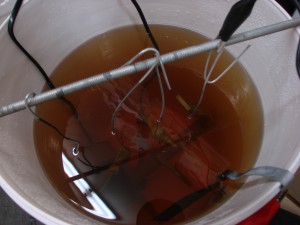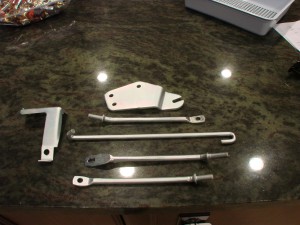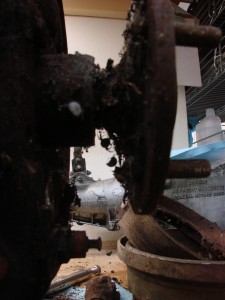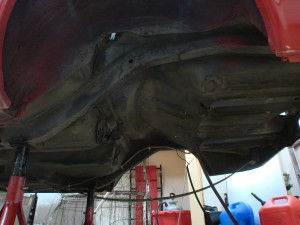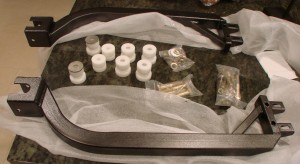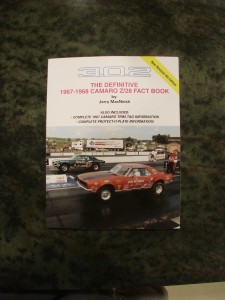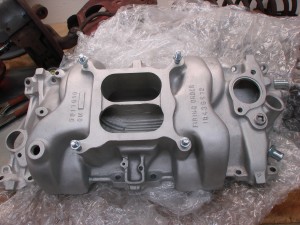John Purner and Complete Custom Wheel
Spoke with John Purner of Complete Custom Wheel today. Not quite ready to order anything yet but had a good chat with him about the project and bounced around some ideas. I ran CCW wheels on both my SM 240sx and on the SS Viper. While I haven’t received any sponsorship or special deals from CCW, I always look to them first. Their wheels offer a tremendous value in custom-sized forged wheels, part of why so many racers run them. I also think the “Classic” style they offer would look good on the Camaro-
/Classic/zoomed/1-1024.jpg)
John was having, as he put it, an “average” day. Well, I don’t know if I could have handled him on a good day – he had me laughing so hard I was practically falling out of my chair.
Turns out John and I share a lot of the same viewpoints on things related to these cars. It was refreshing to find someone else who not only thought like I do, but also felt so free to vocalize those thoughts without a Political Correctness filter. Doubly so, as he’s a guy who has a business selling parts to the public, oftentimes people in that position are so reserved in what they say to preserve their “image”.
I don’t know if I’ll be running CCWs on the Camaro. I don’t get anything if you decide to buy some. But you owe it to yourself to at least consider these wheels at the time of your next purchase, the guy is just that cool.
Caswell zinc plating and blue trivalent chromate
One enjoyable aspect of working on cars is taking something funky and making it nice and clean again. With plastic stuff that usually means throwing out the old and buying a new, but with metal, especially decent metal, there’s usually something you can do to “bring it back”, without having to buy a new part. Plus it’s fun to use as much of the original car as possible.
With the 240sx I had a lot of the suspension components powdercoated. Powdercoat is a much more durable finish than paint , available in a variety of colors and textures. Being a thick coating, it adds a little weight, and won’t work anywhere you have tight tolerances, like in a fastener or on two tightly mated surfaces. I plan to have several things on the Camaro powdercoated. RW Little is a place in San Diego I’ve gone to many times that has good prices and reliably quick turnaround.
Since building the 240 I’ve learned about how DIY’ers can apply other sorts of finishes to their metal parts at home. Another very popular coating in automotive applications is cadmium plating. This is often seen in brake boosters but also in some suspension components, on fuel pumps, or carburetors. The cadmium plating offers excellent corrosion resistance, and a neat yellow sheen when new.
Caswell plating has a range of kits to do all sorts of platings and coatings and anodizing at home. Standard cadmium plating involves some very toxic chemicals and is pretty much banned in CA. Caswell has a good alternative, their “Copy Cad” kit. With it, you apply a standard zinc coating, then dip the parts in a trivalent chromate, leaving the parts with a nice sheen. The most popular is the yellow chromate, which ends up leaving the parts looking just like a freshly cad plated part.
The plating kit arrived last Friday so I got to work-
For all of this, you need distilled water. Needed to go to Target anyway, so we loaded up the cart with 15 gallons.
There’s four buckets you need to do this-
One is a degreaser bucket, orange bucket in the pic below. The degreaser is supplied as a powder to get mixed with distilled water. Parts go in this after they’ve been prepped as a final cleanup stage. This stuff needs to be heated up over 110 to work its best.
Next is a rinse bucket. You use this to rinse the parts after degreasing, and any time you’re moving parts between the other buckets. Mostly you just hold parts over this bucket while spraying them with water to rinse between stages. You can see the edge of the black bucket there, my rinse bin/bucket.
After that they go in to the plating bucket, the white bucket with brown water in it. This bucket gets a bunch of a different powder, and some gnarly brown liquid mixed in. All this stuff is supposed to be pretty safe as far as plating operations go, but note the large box fan to the side. 🙂
The plating bucket gets heated also to about 140. It also gets an agitator pump to keep the fluid circulating within the bucket, which helps the plating process.
The last bucket and step (after another rinse) is the chromating process. Again, this stuff mixes with distilled water. Instead of the old-hat yellow, I opted to go with a blue chromate. It is a little bit less blingy, and a little bit less resistant to corrosion (not that the car is going to see much bad weather ever again), but I like the more understated end result.
To get plating, you suspend the part you wish to plate by a wire. Inside the bucket you place a large-ish sheet of zinc, which you connect to the positive terminal of your power supply. To the negative side, you connect the wire holding the part(s), and away you go. The power supply I’m using goes a bit over 5 amps and is of a constant-current design. Parts stay in the bath for 20-30+ minutes, depending on the size of the part and the desired thickness of the coating.
I decided to start off with a few small parts that aren’t really visible, the three “hangers” for the steering column. Mine were filthy and rusty when I pulled them out of the car-
(Sorry for the cell phone pic, left regular camera inside that night)
In with them are a brake bracket, and the underbody emerbency brake assist hanger thing.
Before the plating process can begin, you need to get the parts down to bare metal. For most of this I used a wire wheel on a bench grinder.
They actually look ok at this point, but left alone, would be back to a rusty funk in very short order.
So into the degreaser, then a rinse, then into the plater. These are some of the clutch mechanism parts I decided to do later, never got a photo of those things in the plating bucket.
Once out of the plating bucket, the parts have a dull gray zinc coating. There is a “brightener” additive available but I didn’t use much of it, didn’t want the parts too shiny.
From there a rinse and into the chromate bucket for 30-60 seconds. A final rinse and hung in front of the fan to dry-
Overall I am pleased with the end results. I don’t quite have the power supply…power to plate the big clutch lever as well as I would have liked. I also didn’t get every last fleck of paint off the original parts, using a bead blaster or sand blaster might have been more effective there than my wire wheel. The pictures don’t capture very well the subtle iridescence of the blue chromate, but it looks quite cool in person.
Here’s some before, during, and after pics of a few parts
This update isn’t totally car related, but other progress is being made, just have to wait for progress updates in other areas. Can see some clues based on doodads visible in some of these pics.
Agricultural 12-bolt and down the rabbit hole
Some of the parts needed for this build are getting harder to find, this is one of them.
The GM 12-bolt is an extremely robust rear-end with an 8.875″ ring gear. It is often compared to the ubiquitous 9″ Ford rearend, the GM piece being a tiny bit less stout, but more efficient (less driveline hp loss).
I’ve been looking for one for a while, and one turned up on Craigslist. The price was good, picked it up Friday.
It is a correct ’67-built Camaro piece. According to the owner, it had been sitting in storage for about 20 years, and then in his yard for the past several months. Based on the dirt removed, by several months, he might have meant 120 months!
Inside the brake drums, an entire ecosystem was flourishing, all sort of spiders and insect carcasses abounded. In this pic you can see the huge black spider that “owned” the passenger side drum-
I don’t think I should count all that dirt as weight reduction, pretty sure it wasn’t there from the factory 🙂
Getting this thing in shape is going to be a bit of work.
My plan was/is to get the car minimally prepped, so I could take it to a welder and have all the big on-car welding projects done. I have taken a welding class, and have access to a good MIG, but don’t trust myself to weld anything critical, like a live axle lateral suspension locator.
The lateral locating device will be attached to the rear axle, so the axle needs to be clean and ready for welding. I also wish to package the device towards the end(s) of the axle. The limit of how far towards the end the device can be located will be defined by the brakes. Hmmmm…down the rabbit hole we go………..
So it looks like maybe I should get the rear brakes put together to ensure I don’t get welded into a packaging dead-end. Now, STX does have a “big brake kit” allowance. Unfortunately, like many of the ST category’s allowances, it is a rather Fisher-Price allowance (“My First BBK”). I can say that, having spent a few years on the STAC – aka the Street Touring Advisory Committee, the “subject matter expert” rules making/advising group for the ST category. I get what they had in mind – the blingy cross-drilled stuff you see in the tuner magazines that are easy bolt-ons for popular cars. Nothing exotic, no messing with the hydraulic system, nothing requiring any engineering on the part of the ST car builder, just bolt-on kit/kid stuff.
Now, there are plenty of “bolt on” kits for the first-gen Camaro. However, none of them are really designed to work with the factory master cylinder, which is rather large (1.125″ bore). Those kits all come with some kind of late-model Camaro or Corvette master cylinder, often with a proportioning valve.
Can’t change the master cylinder, can’t change the booster, can’t add a proportioning valve – at least, not in the classic fashion. Some first-gen Camaros came with a proportioning valve, but that was only the heavier cars with A/C, not the Z28, and even if it did, I couldn’t change it.
The flexible brake lines I can change, the calipers and bracketry I can change, and I can use any rotor equal to or larger than the diameter of the factory rotor or drum. Even the smallest aftermarket stuff is about 12″ (stock drums are 9.5″) so the diameter won’t be an issue. Since the calipers themselves are free, I was thinking I could use one small proportioning valve right at the inlet to each rear caliper. Then I could say it is part of the caliper and thus legal. I expect to receive emails from people saying “hey, that’s not what they had in mind” shortly 🙂
But I’m not totally sure I even want to have a proportioning valve. The Viper had one when I bought it. I ran it that way for a couple events (nothing National, folks). The car from the factory had shorter front tires than rears, and the previous owner raced it with equal sized tires all around. Taking the car back to Stock, I removed the valve as it wasn’t legal, or needed. When the Viper was on the ideal f/r diameter tires, I thought its brakes were the best of any car I’ve ever driven, and a lot of that was the factory blessing the car with a healthy amount of rear bias. When I ran a slightly (.6″) taller front tire, it would try to kill the driver with too much rear bias. So, suffice it to say, there isn’t a ton of room for error in sizing the brake system, but the proportioning valve does give you a bit more leeway.
I won’t go too far into designing a brake system here, but there are several key variables to consider. In my case, some are fixed, some I know or can estimate, and some are free to change.
Fixed:
Master cylinder bore
Brake pedal ratio
Brake booster ratio
Proportioning
Known/estimated:
Static front weight
Static rear weight
Wheelbase
CG height
Maximum deceleration (use this to calc load on front and rear tires at max decel)
Front and rear tire diameter
Free:
Rotor diameter
Caliper piston area
…from all this there’s a bit of thinking to do. You can design a perfect system on paper, but if the parts don’t exist out there in the world, it doesn’t do much good. Not going to have custom calipers made for this. Have to see what is available from Wilwood, Baer, Brembo, Stoptech, etc., and piece together a working system from their available components. Also have to consider – is the car going to get track time? Autocross puts much less demand on brakes than does the track. Most of my track experience is in the S2000, which had somewhat undersized and undercooled brakes, a constant problem.
If the car isn’t going to see much hot lapping, then 12″ rotors will probably be fine. If it is going to be tracked hard, I’d probably want 14″ rotors, as I plan to run only 18″ wheels, and they’d provide the ultimate in thermal capacity. The bigger rotors are heavier though, a disadvantage at autocross. 13″ rotors might be a good compromise. The larger diameter rotors also provide more brake torque with all else equal.
Speaking of weight, the stock rear drum brakes weighed 43 pounds between the two sides. In my STX Z28 spreadsheet, was anticipating losing 7 pounds in rear brakes, would like to stick to that if possible. Also have to retain some kind of parking brake, which adds weight.
Browsing Wilwood’s brake kit chooser site:
http://www.wilwood.com/BrakeKits/BrakeKitApp.aspx
They ask about the axle offset. Hmm. Didn’t have the axle apart enough last night to get this measurement, and even if I did, am I sure it would be right? I’ll be changing the limited slip, and didn’t know if the axles in there were the stock size and length. So one more trip down the rabbit hole, might as well get my limited slip now, with OEM replacement axles (no donuts here Civic guys! ;)), so I can put all that stuff together and measure my axle offset properly. Will need the measurement to be final and exact regardless of whether or not Wilwood stuff is chosen. They list three sizes, 2.75, 2.81, 2.91. Again, not much room for error here!
Will go into a discussion about the limited slip choice later. One somewhat unfortunate thing, is the GM 12-bolt isn’t the hottest diff out there, so it doesn’t have all the fancy choices some other cars get. I’ve had excellent experiences with ATS/Carbonetic in the IS300 and 240SX, and the OS Giken has gained huge popularity in autocross circles as of late. Still, there are some tried-and-true options for this car I think I can make work fine.
So I got things a bit further along today. Didn’t try measuring the axle offset, figured the bug guts might throw it off by .06″ anyway.. 🙂
Whole thing covered in funk and some kind of white paint, got most of it off. As bad as it looked on the outside, the insides look great. Everything very straight and true, turning very smoothly. It had a 3.07 open diff in it, so it’s not likely to have seen much heavy use. The gears all looked better than any of the Viper diffs I’d worked on!
Oh, and speaking of gears, one cool thing about old cars, is you had LOTS of choices-
http://camaros.org/drivetrain.shtml#AxleCodes
…and the Z28 could be ordered from the factory (unlike the dealer-installed cowl-induction or header options) with just about any of them. 3.73 standard. These days, you have to order a whole big option package or something to get a different rear ratio, you never get to choose it individually.
Spoiled no more
As mentioned earlier, the rules are constantly changing within the SCCA, and the ST category (which includes my STX class) is no exception.
Today the November 2010 “Fastrack” was released:
http://www.scca.com/documents/Fastrack/10/10-fastrack-solo-solo.pdf
In it was the announcement that the suggestion to remove 14.2.F was made to the SCCA’s BOD (Board of Directors). The BOD oversee all of SCCA and for the most part, aren’t interested in Solo (autocross). With Club Racing and Pro Racing, we’re sort of the redheaded stepchildren amonst SCCA members, not receiving much attention from the top. In a lot of ways this is for the best, as the recommendations made by the SEB (Solo Events Board) are generally “rubber stamped” by the BOD and we go on our merry way.
As mentioned in the post about my racing background, I have been lobbying for the removal of the aero/body-kit allowance from Street Touring since late 2003. As you can see from my exploits, this stance is clearly not because I don’t enjoy, or find interesting, or find worthwhile from a performance perspective, aero components on autocross cars. I absolutely do. The thing is, I don’t think they belong on Street Touring cars. ST is a great category because it allows you to do enough to make your car work really really well, without making you do stuff that you don’t want to do. Aero is one of those things that can help, especially the lighter cars, but it’s not going to “fix” anything about the car from its Stock form. Not when our average speed is 40mph. There’s been room to do some really wacky stuff for years, and thanks in a large part to the efforts of Team Undercoat Racing at the 2009 Nationals, it looks like ST’s aero allowances are FINALLY going away! A big thanks to them, and to our STAC members (especially Andy Hollis who has been the movement’s most prominent evangelist), and to everyone who wrote in asking for the change.
Of course, whenever there is a change like this, not everyone wins, or is pleased. Among those against those change were buddy Rick Jung, who has built one of the fastest STU Evos in the country, and who put a lot of work into designing a really nice 2-element wing legal for ST, that’s found its way onto a lot of the top STX, STR, and STU cars-
So here’s a shout-out to Rick. I think he’s still making and selling the wings, which I’ve seen successfully used on some Street Modified and Modified-level autocross cars. If you’re in one of those classes and need a great wing give him a ring! http://cirodesign.com/
So….as to how this change impacts the Camaro…
I’d originally envisioned running the car with the original style rear spoiler, because I like those sorts of things, and I think the car looks much better with it. I don’t think it would have made any measurable difference at autocross speeds. Heck, even the huge wing I ran on the 240sx, I couldn’t tell a difference at our average autocross speed (40-43mph on most courses). And no, I wasn’t planning on any enormous wing or spoiler for this thing – I think Penske got the look right and other than larger-diameter wheels and maybe a lower ride height, I plan to deviate from that look as little as possible.
But, believe it or not, the rear spoiler you almost always see on first-gen Camaros was never offered as a factory-installed option in ’67; you could only get them dealer installed. That means I can’t run it in STX in 2011 on the car, unless somehow the rule change either doesn’t go through.
Had planned on running the car in a couple different “trims” depending on the event. I think the car looks a little better without its bumpers too, but of course one must run them in STX. So for SCCA, the trim will be no spoilers and both bumpers. If I take the car to a non-SCCA event, then I’ll probably run both a front and rear spoiler, but no bumpers. Will have to come up with a way of making the rear spoiler removable, without leaving ugly holes in the trunklid. Maybe incorporate some trunk latch pins to the spoiler mounting scheme, making it look even more like a Penske car. 🙂 Even the earliest pictures I’ve been able to find of their Z28s, all have the rear spoiler. Here’s one of the car prepped for Sebring, the second race of ’67-
Car came with a spoiler so I weighed it tonight,
about 6.5 pounds. Doesn’t sound like a lot of weight right now, but I know how hard it is to get chunks of weight that big out of a car after you’ve done the “big ticket” items (spare/tools/jack, seats, battery, and exhaust). At some point I’ll be scrounging for a quarter pound or less, making this seem huge.
Underside of the car is all cleared up, ready for the work to begin. Interior is *almost* done, just need to remove a few more pieces of door and window guts.
Getting there!
Sound deadener no more
It seems popular to add extra sound deadening in these old cars. This was no exception, it had a whole bunch of randomly applied sticky asphalt-based stuff all over the place, underneath the original factory sound deadener. Car might have had a big stereo in it at one point, who knows.
Finished scraping the last bit of it out tonight. Managed to collect most of it in a bin-
Over 24 pounds! So no net savings over the car’s factory weight, but nice to remove some of the chubbiness it’s put on in reaching middle age… 🙂
Almost done taking things apart
The rear end from this car is GM’s lighter-duty “10-bolt” axle. While it’d probably be able to hold up to the power I’ll be making with the tires I’ll be using, the Z28 came with a 12-bolt so that’s what I need to get. The 10-bolt came out today-
Sucker is heavy, I didn’t weight it, but 120-130 pounds is probably about right. I peeked under the drums, the rear shoes were worn down to their rivets. Wonder if they’re the originals?? Haha. I tried not to get too close, there’s probably asbestos in them, not to mention all sorts of other places.
With the axle out of the way I also pulled the fuel tank. Figured with all the welding about to happen back there, didn’t think it’d be a good idea to have 10 gallons of it in there. Instead of siphoning I pulled the tank out with the gas in it, and poured into spare cans. Lots of room back under there with all that stuff out of the way.
Played around a bit with the front suspension, see what sort of bump travel I’ll have available. It looks like it actually starts to curve the right way at the extreme of bump travel, will have to see if I can actually operate there. Was thinking I’d need to find a donor 265/35-18 tire for test fitment, but checked and found the 245/60-14 tires I got with the car, are actually the same diameter! Obviously the “real” tires will be an inch or so wider, but this should help get the suspension travel range in the ballpark.
Found a smokin’ good deal on the driver seat I’ve always wanted. It showed up a few days early, so that was a nice bonus. Won’t be showing it off ’til it’s all mounted in the car.
Not a whole lot left to do in teardown. Going to leave the steering intact for now to make it easier to get the car on the trailer. Need to finish pulling the brake hardlines and stripping the interior. Need to acquire a 12-bolt, then get it going on the road to re-assembly!
Non-terminal steelitis
Some cars are really good from the factory and need little help to be made made super good. Other cars are not so blessed, and need lots of help.
Something I’ve seen a lot of in modern performance cars, particularly turbocharged ones, is a proliferation of “magic little boxes”. One of them is a manual boost controller. Another is a turbo timer. Then there’s the other one to play with the A/F tuning and cam timing. Before you know it, there’s half a dozen little black-box warts all over the interior with their knobs and wires everywhere. Yuck! I hate that sort of clutter, magicboxitis you might call it.
“-itis” is often used as a suffix to describe an inflammation of the -whatever, maybe it’s the tonsils or the colon.
The thing I’ve seen happen with these old muscle cars is a sort of steelitis. The answer to almost every problem is to bolt or weld in some beefy looking steel braces. Subframe connectors, watts links mounts, additional crossmembers for conversion to 3 or 4-link, roll cages, and extra tubes and braces in the engine compartment. Certainly, when done right using good straight paths, these things can be helpful and effective, but so often the cars end up like tanks – strong but heavy. Leaving one to wonder if the car is really any faster than it would have been with a flexible chassis, minus the 200lbs. of steelitis.
A big goal for this car is to keep the weight as low as possible – both in quantity and location :). I’m going to be competing with better-balanced cars on the same size wheel/tire (well, many of the BMWs run 255s, but it’s close), so I have to do everything possible to keep my weight in the same range as them. The RX8s are 26xx with about 50/50 weight distribution, the BMWs in the mid to low 2800’s also around 50/50 and the Subaru WRX in the mid 2800’s, with AWD, but nose-heavy and on 245’s.
I had a huge 33% (650lb.) weight disadvantage to the Civics when I ran the 240sx in STS, but I had some big advantages there too in bigger/better tires and RWD. I think I can get the Camaro’s race weight a lot closer to the BMW and WRX weight than people would expect. Doing so will be critical as I won’t have any sort of tire or drive type advantage.
To make it light, I will have to aggressively treat any steelitis flareups that occur, which is difficult because there are lots of pretty steel parts out there begging to be put on the car. One slipped past my steelitis immune system today, the subframe connectors-
Actually I had made up my mind weeks ago to use these parts, and having them in hand was a prerequisite to the first big set of work I’m having done by someone else, which should be starting in a couple more weeks.
ST allows for bolt-in subframe connectors, which these are. From a design perspective, I like them for a few reasons – one is they tuck up nicely next to the rockers, which should make it easier to get a good middle point of attachment between the SFC and rocker panel. It also reduces the ground clearance hit from the parts; the car is going to be very low, and with the limo like 108″+ wheelbase, the car is going to want to high-center getting on trailers and stuff. They’ll also make it a piece of cake to jack up the car from the side.
But man, the pair weigh 24 pounds!! See, that undoes my 11lbs. of weight savings in rear springs, and another 13 pounds of savings from the HVAC system. On the steelitis mitigating side, they are sprung weight, very very low in the car, fully between the axles so the “cost” of that weight is about as low as it gets, but still, ouch.
A quick aside about chassis stiffness. People tend to go overly gaga about chassis stiffness and torsional rigidity. The new Ferrari has 1x,xxx ft-lbs/degree of stiffness, the McLaren has this, that, whatever. While important, I think it tends to be mostly overrated as a goal for people working with autocross cars, particularly those that won’t be running on big wide slicks. The reason we need chassis stiffness is so that our suspension tuning actually does something. If we want one end of the car to offer relatively more roll resistance than the other, our tuning efforts will be stymied if our stiffening of that end gets absorbed by additional twist in the chassis. If the car is responsive, has the balance you want, and is generally predictable to drive, then you aren’t going to find a ton of time in additional chassis stiffness. In most cases, you will probably make the car slower, as the additional stiffness comes at a huge weight penalty when the car builder succumbs to terminal steelitis in the form of multiple strut tower bars, fender braces, 24-point roll cages, etc.
One other thing to note in the picture above, the little white cylinders. Those are delrin bushings for the front subframe. Delrin is a hard and durable plastic that doesn’t really compress, unlike the rubber bushings used in those spots by the factory. In conjunction with the subframe connectors, those little guys will do a lot to “lock” the front subframe to the body of the car, and add some stiffness to the overall structure. If our rules were more open I’d probably use aluminum in those spots because it’s a bit tougher, but we aren’t allowed to use metal bushings. The Delrin should be fine really. These bushings aren’t the whole subframe/body interlock story, there’ll be more coming later, stuff I’m still working on.
Already have an engine builder involved? That was quick. How hard was it to find an original block? Isn’t the ’67 a small journal? Or had they moved to large journal by then?
The ’67 block was small journal with 2-bolt mains, they moved to large journal in ’68. Small journal maybe not as reliable or as long-lived in a roadracing environment, but should last plenty long in autocross and actually make a couple more hp in the process.
It’s not hard to find an original block. In ’67 the 3892657 block was used by many motors, there was nothing special about its implementation in a 302.
http://camaros.org/drivetrain.shtml#BlockCast
The engine build has been in progress since before the car was acquired, as I figured it would be one of the more tricky and time-consuming aspects of the build. I’m hoping for it to be done by Thanksgiving but Christmas is more likely. Not really a problem as the rest of the car will need a bunch more time than that.
The engine builder was chosen for their long history building successful engines under the SCCA’s strict rulesets, and also for many of those engines being small block Chevys. The latter aspect affords them a great inventory of parts and connections to others who have parts.
Jerry MacNeish
This Jerry guy knows a lot about these cars. He’s been playing with them since before I was born and in doing so has amassed a pretty crazy knowledge base. Jerry is to Camaros as famed autocrosser Andy Hollis is to the Honda Civic/CRX.
A couple things from Jerry showed up today. First was his book,
“THE DEFINITIVE 1967-1968 CAMARO Z/28 FACT BOOK”
Lots of good details, all Z28 specific, will help ensure I get all the little brackets and details correct. Also confirmed (positively, yay!) a lingering gearing availability question I had.
Link to his books – http://www.z28camaro.com/publications.html
While you’re there, check out this car:
http://www.z28camaro.com/unrest68.html
There’s no shortage of myth and legend of what these cars could do from the factory down the quarter mile. Some say they dogged off the line and couldn’t break 15 seconds in the quarter. Others brag of running 10’s with slicks and headers. Any time you hear stories like this, reality probably lies somewhere between. Jerry’s numbers on that page are pretty good on a car with only a couple little ST-ish things done from the factory. This STX car when done should make a little more power and weigh a good 200 pounds less. 🙂
The other thing in the box was an original mint-condition intake manifold for the car. It was supposed to go straight to the engine builder but what the heck, this gives me a chance to photograph it before the motor is all put together.
Can’t wait to be done with all the dirty scummy parts, and start putting together the nice clean new stuff.
Further suspension dissection
Got a bit further into the suspension today.
Thought I’d start the day by pulling the seat covers off the rear seat frame, to help get rid of some of the smelly funk in the garage. I had planned to maybe replace the whole thing, but each frame for the bottom and back is bucks ($600+) so figured I’d strip it down the the frame, powdercoat, then re-cover.
There were TWO covers on the bottom! Instead of re-covering the original, someone put a new black cover over the original blue vinyl. All this mess was held in by a million of the little metal bent staple things. Probably a pound weight savings right there! Will be nice to have that stinky stuff gone but doing so burned a ton of time.
So on to the rear suspension. Got the rear axle free of the springs and brake lines, and jacked it up to around where I figured its “working” ride height would be. Wanted to see how much room there’d be to package the gear I have in mind for back there-
Looks like 5″ from this pic but it’s really more like 4-4.5″. Will probably be enough for what I want to do. I imagine some people are expecting me to introduce some kind of new-fangled cutting edge live axle lateral locating device, but unfortunately for them, I have no such plans. Effectiveness, light weight, and simplicity are the goals. Surprisingly, none of the big aftermarket vendors for these cars make a simple panhard rod kit. There are a few watts link kits out there, but they all look very heavy.
Below is a simple and effective lateral locating device found on a very successful car.
From the factory, the car depends on the leaf springs to function as the springing medium, but to also control the axle’s lateral, longitudinal, and torque movements. In a way this is really clever, as you don’t need all sort of control arms and bushings, it is all really simple. Unfortunately as with anything you ask to do too many things, the leafs end up compromised and not doing any one of those tasks very well.
Below are the leaf springs I plan on running, at least initially. I have to stick with leaf springs per my rules, can’t go to coils, and things like springs embedded within the shocks are also not allowed. I could try to do some sort of crazy progressive bump stop tuning to use those as the spring, but I don’t like bump stops and don’t plan on running any.
These are Hypercoil composite leaf springs, one of them side-by-side with a stock mono-leaf rear spring. The Hypercoil spring here is 250lb/in., and has about 3″ less “arch” than the stock spring. I suspect even with that much less arch, the rear of the car is going to be too high for my purposes. The spring I pulled off the car had a rate probably around 80lb/in. The ’67 Z28 had a stiffer stock rate, probably around 125lb/in. Double that rate sounds high but I don’t suspect it will be, as tire and shock technology has come a long way.
This will give the rear a ride frequency just over 2hz, which should be in the ballpark. There is no real “motion ratio” for a live axle in ride, a 1″ suspension movement equates to 1″ of spring compression.
Ride height adjusments aren’t very easily done with longitudinal leaf springs, so that’s something I’ll have to work out when the time comes.
Oh, these composite rear leafs as a pair are over 11 pounds lighter than my super-soft stock rear steel mono leafs. Not a huge reduction, but for a car using big multi-leafs to achieve a high rate, probably lots more weight to be lost.
The front fares a bit better. It uses a traditional upper and lower a-arm suspension, albeit with really awful geometry. It’s funny to see, at full droop, the car actually has several degrees of negative caster.
The stock spring is 16″ long! 16″ also happens to be the effective length of the lower control arm – the distance from their inner pivot point, to the center of the lower ball joint.
The shock mount and spring seat is centered at a distance of 9″ from the inner pivot point. This gives a not-too-great motion ratio of .316. What this means, is we don’t get a lot of travel at the spring/shock for a unit of travel at the wheel/tire. This necessitates higher spring rates, and shocks that can properly handle those higher spring rates. Fortunately I have a really great set of shocks left over from the Viper, so I should be able to get the valving I need. I haven’t seen the motion ratio for a first-gen Camaro published before and didn’t know how it would be until I put the arm on the workbench today. Seeing it now I’m not surprised people have trouble getting them to work well with stiff springs. Unless you go to a custom arm that really improves the motion ratio, you’re going to need a shock capable of massive low-speed damping to keep one of these front suspensions under control.
My STS 240sx used 550lb. front springs with a strut suspension that provided near a 1:1 motion ratio, its wheel rate was around 500. That was pretty high for a car that only had about 700 pounds on each front corner. Like the Camaro, it had really bad suspension geometry, especially when lowered, so I used a fairly high spring rate to keep it from moving too much; it also had a sharp fender seam that would cut into the tire on a bad bump.
To get an equivalent wheel rate is going to require a spring rate well up into the 4-digit range, over 1500lb/in. by my calculations. I probably won’t go quite that stiff, at least not at first, as I plan to use a stiffer front sway bar on the Camaro than I used on the 240sx. The stock spring rate on my Camaro was around 330lb./in, the Z28 of this year only had about 380lb.in.
I believe it was Colin Chapman who was credited as having once said “Any suspension will work…if you don’t let it”
My interpretation of this sentiment, is that if you can set your static figures (camber, caster, toe) in a good and happy place, then just not let the suspension move very much, you are probably going to be okay. Things like camber curves and bump steer curves are important, and if you’re in a class where the rules allow you to properly re-engineer those things, doing so is worthwhile. But if you aren’t allowed to re-engineer those things, and are dealt (or choose) a car with crummy bump steer and camber curves, then give the car plenty of static negative camber (I ran -4.5 degrees on the 240sx) and make it stiff enough so the outside front tire is still in a “happy place” at terminal roll. Sure, your inside front tire may be riding on its inner edge, but especially in these big heavy production cars, the outside tire does pretty much all the work in the corner anyway.
So the above summarizes my philosophy and approach to how I plan to make the front suspension on this car work. It’s going to have a lot of static negative camber, people will probably think it looks funny. Donohue never figured out a way to get the front of his car to work without a ton of static negative either, so who am I to try?
I’m also a big fan of adjustability, so the finished front suspension will fully adjustable for ride height, camber, caster, and toe using a combination of both the factory methods and the allowances we have in ST for camber kits and replacement control arms. I think it is important as a builder to give yourself a wide range of adjustment, and to never be at the extreme of any adjustment range you have. You should always have one more hole, or shim, or click of the knob to go in any direction, at least under normal circumstances (i.e., a normal dry surface).

